Deep in the frigid waters of the arctic ocean lurks a large and heavy creature shrouded in mystery: the Greenland shark. This so-called “sleeper shark” is a massive predator and the longest-lived vertebrate that we know of. It can grow up to 6.4 meters (21 feet) and live over 500 years, and its toxic flesh enables it to survive at depths of below 2,200 meters (7,200 ft) and in freezing waters.
But despite its massive size and longevity, very little is actually known about this elusive shark. Here’s what we know about it so far.
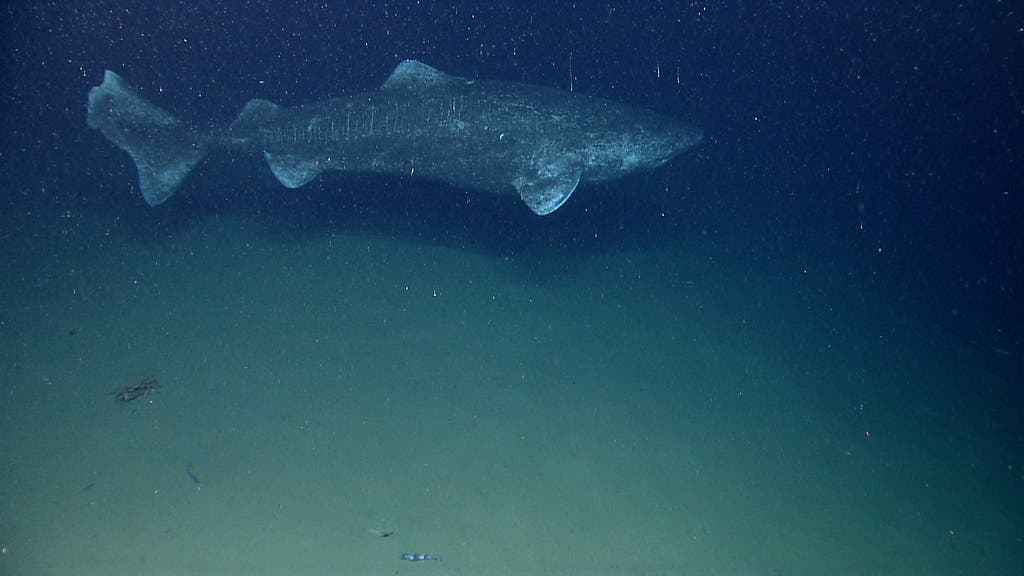
A “living fossil” with poor eyesight
Sharks evolved some 450 million years ago, before dinosaurs or even trees came to be. The Greenland shark is part of a family called sleeper sharks that are also ancient, over 100 million years old. The family is called Somniosidae, with Somnus being the Roman god of sleep.
They’re called sleeper sharks because they move so slowly through the water. The Greenland shark (Somniosus microcephalus), for instance, typically swims at about 1.2 km/h (0.77 mph), with its fastest cruising speed only reaching 2.6 km/h (1.6 mph). This is slower than most seals and most fish as well, which made several researchers question how they can even hunt.
To make matters even worse for the shark, their vision is often impaired by parasites that attack their eyes; it’s not uncommon for Greenland sharks to have almost no vision at all — but they can still navigate using their sense of smell. In fact, most Greenland sharks are believed to be infected with a parasite (a copepod called Ommatokoita elongata) that affects their vision. Some researchers have even speculated that because the copepod may be bioluminescent, it could form a mutualistic relationship with the shark by attracting prey, but this has not yet been confirmed.
The Greenland shark also disproves a common myth about its kin: that sharks need to constantly swim. In fact, some sharks, including the Greenland shark, can remain motionless for a time. Most sharks need to constantly swim in order to bring oxygen-rich water to their gills, but some can still breathe while stationary. The Greenland shark’s circulatory system is specially adapted for this, which is particularly important as the shark extracts oxygen while swimming at low speeds. Its special adaptations also allow it to survive in frigid waters, sometimes even below freezing (seawater doesn’t freeze at fresh water’s freezing point).
But perhaps the most spectacular thing about it is its extremely slow growth rate and its remarkable lifespan. They don’t even reach sexual maturity until they’re around 150 years old and they can live over 400 or even 500 years old, making them the longest-living vertebrates we know of.
In order to figure out how long the sharks live, researchers tag sharks and recapture them later, measuring their growth date. They also date them using radiocarbon dating of crystals within the lenses of their eyes, but these methods still have a range of accuracy.
Despite their size and longevity, however, not much is known about their behavior and ecology.
A slow but formidable predator
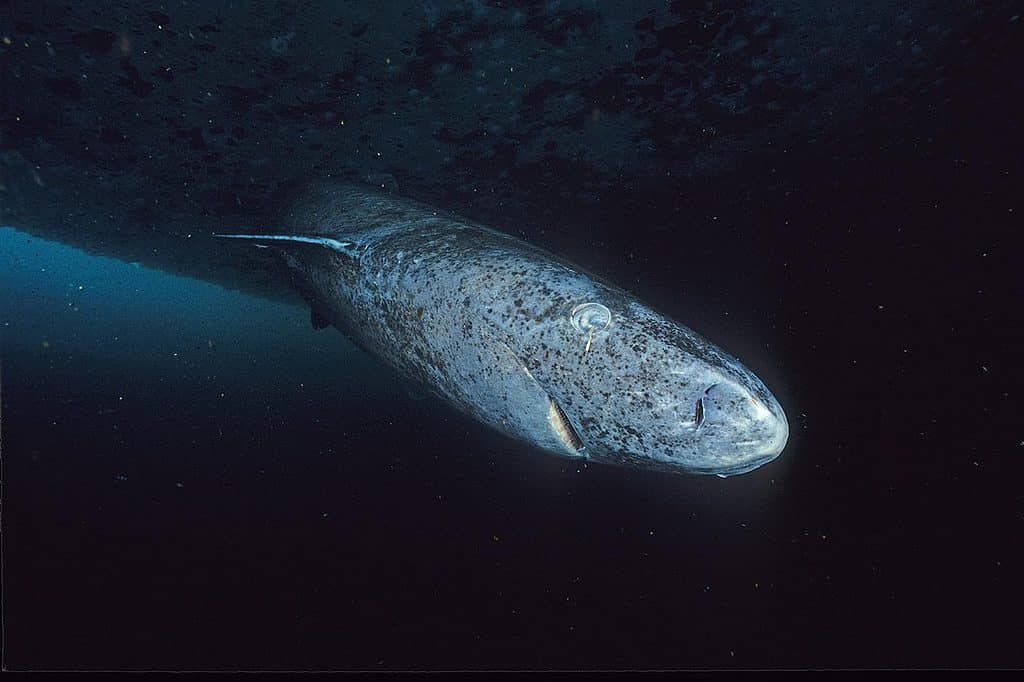
Despite its slow movement, the Greenland shark is a formidable predator — an apex predator at that. It feeds on a wide range of prey from fish and seals to whales and even reindeer or horses. A dissected Greenland shark even had the remains of polar bears in its stomach.
It’s not clear if the Greenland shark hunts and kills all of these or simply feeds on their remains. The shark has been spotted eating carrion and there’s some speculation that this comprises a large proportion of its nutrition, but because the Greenland shark is so hard to observe in its natural habitat, we don’t know for sure. Scientists believe that this scavenging behavior and its keen nose allows the shark to survive in frigid waters where there’s not a lot of prey.
However, the Greenland shark doesn’t seem to shy away from attacking large creatures, as was the case when one shark hunted a moose it almost choked on (the shark had to be saved by humans).
Like most sharks, if it grabs on to something, it doesn’t want to let go. It has 48-52 teeth in its upper jaw and 50-52 teeth in the lower jaw — pointed teeth that help the shark hold on to larger food. The sharks can move their head in a circular motion. However, as it’s a slow swimmer, it likely hunts prey that is asleep.
Also, while it is thought to be an apex predator, the Greenland shark may not be safe from other predators. In particular, sperm whales (Physeter macrocephalus) seem to hunt it. Greenland sharks have been observed to flee when they hear the calls of sperm whales, and researchers also found other circumstantial evidence that may hint that some sperm whales hunt Greenland sharks.
Greenland sharks outside Greenland
Names can be deceiving, and this is definitely one of those cases. The Greenland shark, a solitary creature rarely seen in groups, is a good long-distance swimmer and has been spotted anywhere from eastern Scandinavia to the Caribbean.
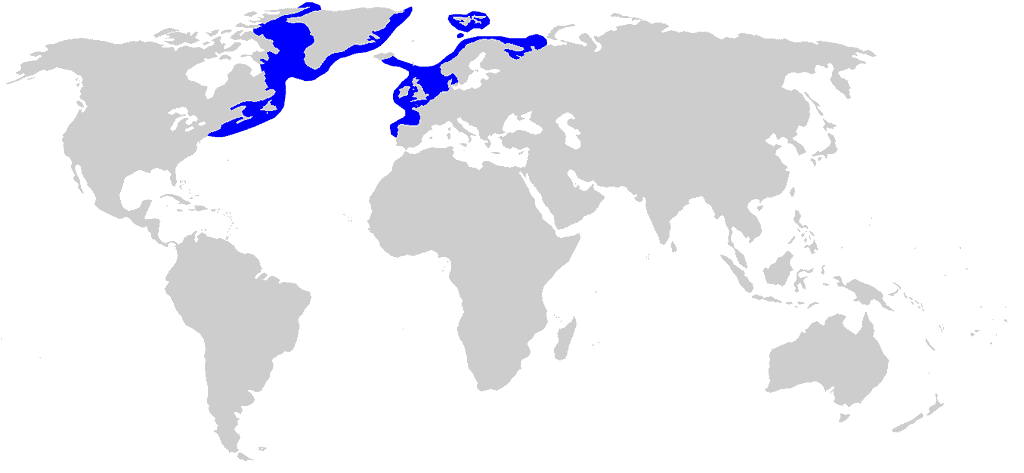
The shark can also go remarkably deep, being spotted in the Gulf of Mexico at a depth of 1,749 m (5,738 ft), where the water temperature was 4.1 °C (39.4 °F). The shark rarely seems to go lower than 1,500 m, but it doesn’t shy away from deep environments as it seeks its preferred cold water (−0.6 to 12 °C or 31 to 54 °F) habitat.
Despite its fierce reputation and wide range, the Greenland shark is not a threat to humans. Although some cultures have myths about people being attacked by Greenland sharks, there’s no recorded mention of this happening (maybe also because the shark prefers cold waters where people rarely swim). Also, the Greenland shark is generally shy and avoids contact with people.
Although they don’t seem to be very sociable, Greenland sharks can give birth to over 200 live pups at one time according to some estimates (though other estimates are far more conservative and estimate around 10 pups per pregnancy). The sharks are around 14 to 18 inches (35 to 45 centimeters) long when they’re born and, as mentioned, it will take them over a century until they can mature enough to produce offspring of their own.
However, not much else is known about their reproduction — we don’t know how many of these pups survive or how (if) they are taken care of by their parents.
The gestation also takes a very long time: one study estimated that there’s a gestation period of 8-18 years but as is often the case with the Greenland shark, this is contested because we just don’t have enough observational information about it.
Threats and conservation
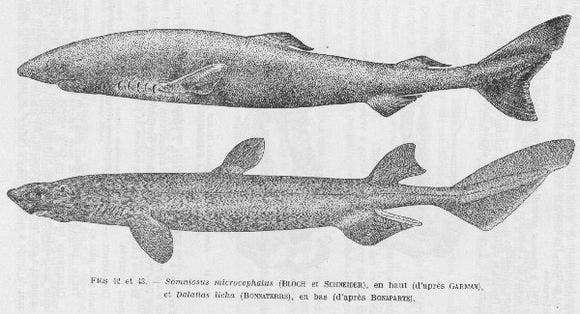
Greenland sharks are widely regarded as the longest-lived vertebrates on the planet. They grow at a slow rate, have a long gestation period, and it takes them a very long time to reproduce. All this makes the species vulnerable to threats like overfishing.
Currently, the species is considered “near-threatened” but again, we don’t really know much about the population because it’s so hard to observe them in the wild.
The main threat (or one of the main threats) faced by Greenland sharks is overfishing. They’re often caught as bycatch in commercial fishing operations, but sometimes they’re specifically hunted, either in traditional medicine or as a delicacy in Iceland.
The Greenland shark’s skin is toxic because it accumulates urea, an adaptation that enables it to survive in cold environments. There’s even an Inuit legend about this: according to myth, an old woman washed her hair in urine (a common practice to kill head lice) and dried it with a cloth. The cloth flew out into the sea and became the first Greenland shark. Another, more gruesome legend tells of a father who killed his daughter by drowning her, cutting her fingers as he did so. Each of the fingers went on to become a sea creature, including one that became the Greenland shark.
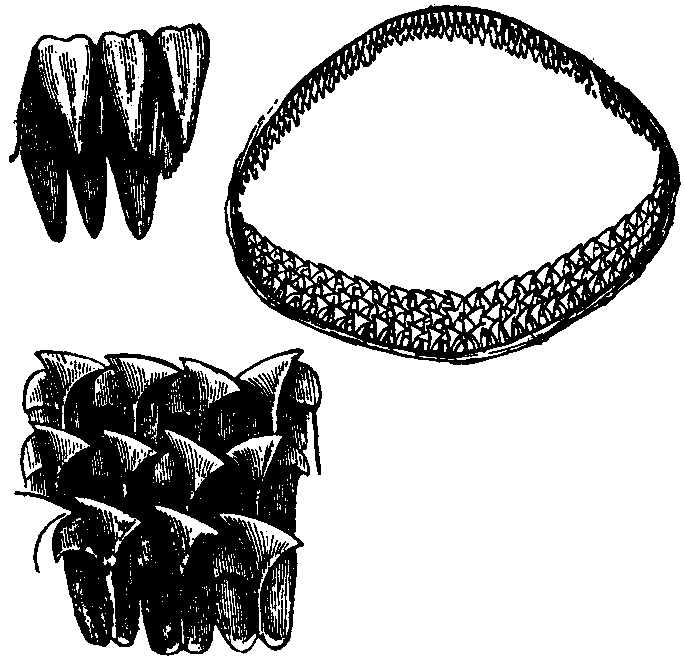
At any rate, the meat of a Greenland shark is toxic and not safe for consumption by humans or animals. But people are creative — and cruel. We’ve found ways to treat it. By boiling it in several changes of water and then drying and fermenting it for several months, humans produce kæstur hákarl — fermented Greenland shark that is considered a delicacy in Iceland, and is sometimes consumed in traditional Chinese medicine.
Overfishing, both intentional and unintentional (an estimated 3,500 Greenland sharks are accidentally caught as bycatch per year), is probably the biggest threat the Greenland shark is facing (and this is true of all sharks). The same longevity that makes them so amazing is also what makes them vulnerable: because it takes them so long to become sexually active, and because they can live for so long, every captured Greenland shark can make a big difference for the population. Although it’s hard to estimate because they are so difficult to study, it’s estimated that Greenland shark populations have declined by 30–49% or even more. This prompted the IUCN to change their assessment from “Near Threatened” to “Vulnerable.” But many feel that’s not enough.
“There’s still so much we don’t know about them: how many they are, their abundance, their population structure, we have no idea where they go to mate, or where they go to have their pups. We don’t know how many pups they have or how often they reproduce,” Brynn Devine, an Arctic fisheries adviser at Oceans North, told Mongabay. “And that makes conservation planning particularly challenging because those are the things that you need to know to understand how at risk a species is to things like bycatch.”
So most biologists rejoiced when, at their annual meeting in Portugal, the Northwest Atlantic Fisheries Organization (NAFO) prohibited the retention of Greenland sharks in international waters. “It was a long time coming, but not a long time in the life of a Greenland shark,” Sonja Fordham, president of Washington, D.C.-based Shark Advocates International, who attended the recent NAFO meeting in Portugal, told Mongabay.
Climate change also poses a threat to them. Thousands of Greenland sharks are killed in and around melting ice every year, and as temperatures rise, more ice melts — and the more ice melts, the more routes are also opened for commercial fishing. So offering them timely protection could be a much-needed lifeline.
A mystery in the deep
Sharks are majestic and surprising creatures, and the Greenland shark is a worthy member in the Pantheon of shark species. Despite researchers’ best efforts to study it, it remains a fascinating and mysterious creature of the deep. With further research and conservation efforts, we can hope to better understand and protect this ancient predator of the oceans and with it, its links to the rest of the ecosystem.
Researchers don’t really know why these sharks live so long, where they roam, what’s their relationship to other predators, and many other questions.
We’ve explored so little of the oceans, it would be a shame to destroy these animals before we get a chance to understand them.


